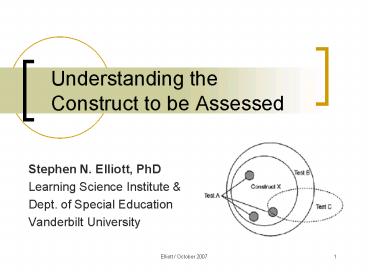Understanding the Construct to be Assessed - PowerPoint PPT Presentation
1 / 19
Title:
Understanding the Construct to be Assessed
Description:
To form by assembling parts; build. To create by ... Levels of Inference: Abstractive to existential. Thank goodness for test items that yield scores! ... – PowerPoint PPT presentation
Number of Views:34
Avg rating:3.0/5.0
Title: Understanding the Construct to be Assessed
1
Understanding the Construct to be
Assessed
- Stephen N. Elliott, PhD
- Learning Science Institute
- Dept. of Special Education
- Vanderbilt University
2
Construct Dictionary Definition
- To form by assembling parts build.
- To create by systematically arranging ideas or
expressions. - Something, especially a concept, that is
synthesized or constructed from simple elements.
3
Basic Premises
- Understanding the construct to be assessed is
critical to developing a plan to validate the
resulting test score interpretation. - Understanding what is meant by the term construct
is important to facilitating communication with
test score users and others interested in student
achievement.
4
Constructs Test Score Validity Some History
- The term construct logical or hypothetical
originated in Betrand Russells 1929 maxim that
wherever possible, logical constructions are to
be substituted for inferred entities. - McCorquodale Meehl (1948) distinguished
hypothetical constructs (unobservable, inferred
entities) from intervening variables
(abstractions from observations). - Since the 1954 Test Standards published by APA.
Construct validity was defined in the Standards
as the degree to which the individual possesses
some hypothetical trait or quality construct
presumed to be reflected in the test
performance.
5
More History Construct as Attribute
- The concept of validating a construct was more
fully developed by Cronbach Meehl (1955) who
referred to a construct as an attribute. They
went on to list construct validation procedures
(a) criterion-group differences, (b) factor
analysis, (c) item analysis, (d) experimental
studies, and (e) studies of process. - Through work of Cronbach with contributions from
Messick (1980, 1989), the common view is one
conception of validity referred to as construct
validity. Thus, the validation of a test score
can be taken to include every form of evidence
that the score to some acceptable extent measures
a specified attribute quantifiable property of
quality of a respondent.
6
Nature of Attributes
- Observable and unobservable
- Achievements and aptitudes
- Levels of Inference Abstractive to existential
- Thank goodness for test items that yield scores!
Items - help defined the content from which we make
- attributions. These attributions often take the
form of a - test score interpretation.
7
Test Score Interpretation
- The proposed interpretation refers to the
construct or concepts the test is intended to
measure. Examples of constructs are mathematics
achievement, performance as a computer
technician, . To support test development, the
proposed interpretation is elaborated by
describing its scope and extent and by
delineating the aspects of the construct that are
to be represented. The detailed description
provides a conceptual framework for the test,
delineating the knowledge, skills, abilities, to
be assessed. -
(AERA, APA, NCME, 1999, p. 9)
8
Our World Student Achievement
- We are interested in understanding student
achievement. That is, the knowledge and skills
students posses at a given point in time in
content domains of language arts, mathematics,
and science. - We gain insights into student achievement by
observing the amount or quantity of knowledge and
skills students posses in these defined content
domains. This amount or quantity of the measured
attribute takes the form of a test score. - We attribute more knowledge or skills for samples
of behavior or work where students demonstrate
correct responses to a correspondingly larger
number or more complex type of items. - Our interpretations about student attributes are
situated within broad academic content domains
and framed by performance level descriptors.
9
Construct Logic Simplified
Test Score Interpretation Abstracted Attributio
n
Observed Inferred Performances on Item/Task
Test Score
10
Unified View of Validity
- 1985 Test Standards and Messicks epic chapter
united all types of validity under construct
validity. As described by Messick, construct
validity is the unifying concept of validity
that integrates content and criterion
considerations into a common framework for
testing rational hypotheses about theoretically
relevant hypotheses. (1989)
11
Information Sources for the Constructs Assessed
with AAs
- States academic content standards,
- States academic achievement standards, in
particular, the Performance Level Descriptors for
each content area, - Validity alignment studies as reported in
Alternate Assessment Technical Manuals, and - Reports to consumers of the assessment results.
12
Sample Content Framework
13
Sample Performance Level Descriptors
14
Sample Evidence Based Support for Construct
Claims
15
Another Sample of Evidence to Support Construct
Claims
16
More on Validity Test Score Interpretation
- As we investigate the constructs measured by
alternate - assessments, we are confronted with a number of
issues - that affect the validity of the test score
interpretation. For - example
- Teachers support and prompting,
- Tests with items or tasks that are non-academic,
- Assessments that sample a limited portion of the
intended domain, and - Item or task rubrics that score for more than
achievement.
17
Construct Underrepresentation Construct
Irrelevant Variance
18
Understanding the construct assessed is
foundational
- A validity argument provides an overall
evaluation of the plausibility of the proposed
interpretations and uses of test scores.To
evaluate a test score interpretation, it is
necessary to be clear about what the
interpretation claims.
(Kane, 2002)
19
Thanks more
- Key References
- AERA, APA, NCME (1999). Standards for
educational and psychological testing.
Washington, DC Authors. - Kane, M. (2002). Validating high-stakes testing
programs. Educational Measurement Issues and
Practices, 21 (1), 31-41. - McDonald, R.P. (1999). Test theory A unified
treatment. Mahwah, NJ LEA. - Messick, S. (1989). Meaning and values in test
validation The science and ethics of assessment.
Educational Researcher, Vol. 18 (2), 5-11. - Contact Information
- Steve.elliott_at_vanderbilt.edu































